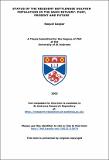Files in this item
Status of the resident bottlenose dolphin population in the Sado estuary : past, present and future
Item metadata
| dc.contributor.advisor | Hammond, Philip Steven | |
| dc.contributor.author | Gaspar, Raquel | |
| dc.coverage.spatial | xvi, 194 leaves | en_US |
| dc.date.accessioned | 2017-06-09T13:14:29Z | |
| dc.date.available | 2017-06-09T13:14:29Z | |
| dc.date.issued | 2003 | |
| dc.identifier | uk.bl.ethos.669700 | |
| dc.identifier.uri | https://hdl.handle.net/10023/10974 | |
| dc.description.abstract | The main aim of this work was to determine the past, present and future conservation status of the bottlenose dolphin population inhabiting the Sado estuary region, Portugal, using a long term (photo ID) data set. Resident animals, identified from their strong resighting pattern, were confined to the estuary region. There is little evidence of social interchange with other coastal bottlenose dolphins and the role of emigration and immigration is unclear. This is a very small population. Numbers of animals have decreased in the past but now seem to be increasing. A mark-recapture analysis of individual capture histories showed that time changes in age-specific survival explained the observed changes in number of animals. Survival was lower, particularly in young animals, in earlier years which have resulted in a long period of lack of recruitment to adulthood. In the most recent years survival has increased, especially for calves in their second and third years. Fecundity has also been higher. Protected areas and proposed marine SACs reflect the importance of the Sado estuary region; this is also an area of intense anthropogenic activities that threaten the dolphin population. Population viability analysis was conducted using the software VORTEX incorporating estimates of past or current vital rates. The likely future of the resident population is for it to decline, especially during the next few decades. A viable population was only predicted if maximum values of vital rates were used or if regular immigration occurred. A number of proposals for management action are discussed. This work constitutes an example in conservation biology where life history parameters were estimated, and used to predict future viability and thus to indicate management actions that could increase the chance of saving a very small marine mammal population. | en_US |
| dc.language.iso | en | en_US |
| dc.publisher | University of St Andrews | |
| dc.subject.lcc | QL737.C432G2 | |
| dc.subject.lcsh | Bottlenose dolphin--Portugal--Sado River Estuary. | en |
| dc.title | Status of the resident bottlenose dolphin population in the Sado estuary : past, present and future | en_US |
| dc.type | Thesis | en_US |
| dc.contributor.sponsor | Fundação para a Ciência e Tecnologia (Portugal) | en_US |
| dc.type.qualificationlevel | Doctoral | en_US |
| dc.type.qualificationname | PhD Doctor of Philosophy | en_US |
| dc.publisher.institution | The University of St Andrews | en_US |
This item appears in the following Collection(s)
Items in the St Andrews Research Repository are protected by copyright, with all rights reserved, unless otherwise indicated.

